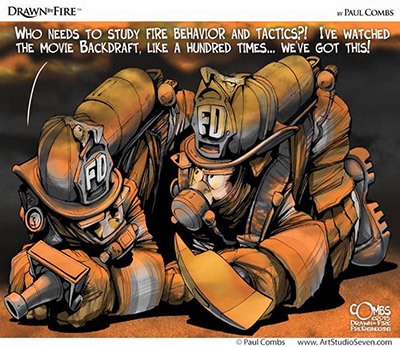Change is something that most of us dread and organizations can move at a glacial speed to implement or adopt. As difficult as it may be, change is about to cast a large net over the structural firefighting profession and likely alter decade old suppression tactics used by many fire departments.
“The National Park Service, along with fire departments across the country, should always avail themselves to the latest research and analyze and adapt their tactics accordingly to make sure all firefighters go home after every shift." Hal Spencer, NPS Structural Fire Branch Chief

©Paul Combs. Used with permission.
Historically, the development of fire suppression strategies and tactics has primarily occurred from blood, sweat, tears, near misses, trial and error, and unfortunately the well-documented loss of life. This approach has provided the profession with many valuable tools, but has never given us the means to fully measure and understand how these approaches have actually impacted fire.
Changing Times
This has all changed. Over the last 10 years, scientific studies conducted by Underwriters Laboratories (UL) and the National Institute of Standards and Technology (NIST) have caused the fire service to take a thoughtful look at how we have been fighting fires and have uncovered some serious flaws and misconceptions in our strategies and tactics. Significant changes in building construction, materials, configurations, and fuel loads, which have a much higher concentration of plastics and other synthetics, all cause fires today to burn hotter and in a more volatile manner in a shorter amount of time.
Researchers have made some significant discoveries - venting is not always a life saver, water cannot push fire into other parts of the structure, and flowing water into the structure from the outside actually slows fire growth, reduces temperatures, and improves conditions throughout the structure for occupant survivability and firefighters' safety.
The International Society of Fire Service Instructors (ISFSI) has recommended that departments review and adjust their tactics and training programs to incorporate current research into their emergency response operations by cooling the fire as quickly as possible, flowing water into the structure from the outside and managing air flow paths with greater emphasis on ventilation control. In addition, the ISFSI encourages the adoption of the SLICERS acronym for a sequential action plan for the initial engine company arriving on the fire scene. SLICERS stands for sizing up the incident, locating the seat of the fire, identifying and controlling the air flow path, cooling the fire from the safest location, and extinguishing the fire. Rescue and salvage now become actions of opportunity.
How the National Park Service is Using New Research
Following these recommendations, the NPS is actively reviewing our existing curriculum and has incorporated many of the recommendations into our structural firefighter refresher program so that our firefighters and partners can continue to improve safety and efficiency on the fireground.
“It is our plan to present a standardized curriculum emphasizing the lessons that come from validated research into our firefighter live fire refresher course. For the next two years, we will be implementing some lessons and field testing others to ensure that all of our firefighters are exposed to the latest tactics and knowledge to safely suppress structure fires,” reports Harold Spencer, Branch Chief for NPS Structural Fire.
Refreshers include new lectures targeting evidence-based practices for strategic and tactical firefighting, SLICERS, modern-day fire behavior, and crew staffing performance. Lectures can work well, but implementation and hands-on training is essential. New skills and tactics have been incorporated into live fire drills, enabling participants to practice and see the effects they have on fire development and suppression.
“The National Park Service, along with fire departments across the country, should always avail themselves to the latest research and analyze and adapt their tactics accordingly to make sure all firefighters go home after every shift,” reports Spencer.
Departments that have implemented these new principles have seen some incredible results. For example, the Los Angeles County Fire Department has reported a 45% decrease in firefighter injuries and a 7% decrease in property damage.
“We are a small organization compared to many fire departments, but this may be a chance for the National Park Service to be seen as a leader in the profession,” states Spencer.
For more information on research and training, visit Modern Fire Behavior.
Tags
Last updated: July 7, 2015
